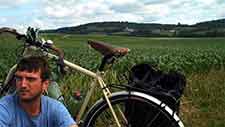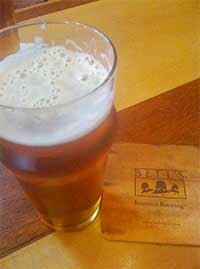Why did I spend 5 months pedaling 4,300 miles across the country to rediscover our food system? Before I answer that question, I must point out that a major transition in my personal life and the undertaking of this journey had inexplicably collided with 3 timely events:
- The economic collapse of 2008 reared its ugly head. While our newly elected President, Barack Obama was busy bailing out big bankers on Wall Street – the middle class working on Main Street were struggling to get by. No one felt the shattering impact more than our nation’s farmers and rural communities.
- Our food system had become a hot topic. 2 months after my departure the controversial documentary Food Inc. was released claiming that agribusiness produces food that is unhealthy, environmentally harmful and abusive of both animals and its employees.
- The social media phenomenon was in full swing. Web based services such as YouTube, Twitter, Facebook were growing their user base at an exponential rate. Suddenly, sharing user generated content with the masses was as easy as two taps on an iPhone.
It was the perfect recipe for an interactive journey into our food system. Before this nomadic excursion came to me I was busy working for a software development company specializing in the delivery of data driven fantasy sports applications. I was competing in the rat race of Los Angeles, working nearly 80 hours a week and trying hard to grab the attention of my peers. One morning it was business as usual until I got called into a meeting and informed that the company I had faithfully served was no longer in need of my services. Like millions of other hard working Americans, I had gotten laid off and was now in the unemployment line.
With a plethora of much needed free time on my hands I made a typical visit to the dog park with my beautiful dog Chaya. As she wrestled with her canine friends, I soaked up the sun and overheard a man rambling on and on about his wonderful getaway in Thailand filled with pristine beaches, cheap lodging and 2 hour Thai massages. His enthusiasm undoubtedly resonated with me and two hours later I returned home and booked a ticket to Bangkok. What can I say? I was feeling spontaneous.
For the last 2 weeks of what turned out to be a 2 month soul searching quest through South East Asia I drank cocktails and spent countless hours drifting aimlessly on a raft off the Island of Ko Chang. As the days slipped by and I carelessly squandered the hours bobbing up and down on the crystal clear waters, I started to reminisce about one of my favorite books written by Peter Jenkins called A Walk Across America. Ultimately, Jenkins’ disillusionment with society in the 1970’s drove him out onto the road on a walk across America to find himself. It was an amazing story full of personal growth, adventure and American culture. Needless to say I was in a place in my life where I could genuinely relate to Jenkins, his wanderlust and his state of confusion.
Don’t get me wrong, before this trek I had done my share of American travel. In fact, I accrued well over 50,000 road trip miles via automobile. As my gas powered engine whipped me across the heartland in pursuit of national parks and the next tourist attraction, I had never taken the time to get to know my fellow Americans. More importantly I had never taken the time to get to know the people in small towns across America. Suddenly, I was consumed by an overwhelming sense of discontentment and as far as I was concerned there were too many stones I had left unturned. This is when I decided to embark upon my slow journey across America.
It took Jenkins 3 years to walk from Connecticut to New Orleans. I decided a bike ride would suit me better.
With my new found mission and in preparation for my upcoming journey I returned to my hometown in central Pennsylvania where I witnessed a huge transition in both the landscape and the local economy. I hadn’t been home in well over a year and I was quick to notice that Pennsylvania no longer felt like the rural and scenic hometown I had remembered growing up. Instead, I observed so much farmland lost to commercial and residential development that I could barely recognize the place. And sure enough, according to the American Farmland Trust, Pennsylvania had lost 1.6 million acres of rural land due to development between the years of 1982 and 2007. It seemed as though everyone back home was now living in some housing development called “Cedar Meadows” or “Pine Trail Estates”, but without the meadows or pine trails.
In such difficult economic times I grew frustrated to know that the only “local” businesses that seemed to be thriving were the corporate giant Wal-Mart and its nearby fast food establishments. It just seemed odd to me that people were willing to give their money to multi-billion dollar corporations before they would invest in their own community. Granted, I had just come back from Southern California, one might anticipate a good bit of culture shock when returning home to a small blue collar town. But still, why weren’t the local establishments thriving? What had happened to much of the pristine farmland I remembered from my youth? Was this happening elsewhere? There was only one way to find out.
My journey now had a purpose and I was in search of the true answers. It was time to hit the road.
Read the Unconventional Harvest series:
- On the Road to Find the Future of Food and Farming
- Grassland Organic Farm
- Wellspring Farm
- My Visit to an Amish Farm in New York
- Farm Sanctuary
- An Urban Oasis for Food
- Tantré Farm
- Conventional Dairy Farmer Art Thelen
- New Forest Farm
- A Large No-Till Organic Farm
- Melstone, Montana—Population 136
- In the Farmers Own Words
Nathan Winters rode a bicycle across America to discover first-hand why our food system had grown to be unsustainable, and to find alternative solutions. He traveled into the homes and communities of organic, conventional, urban and Amish farmers and community organizers. This ongoing series—to be posted every other Wednesday— represents select material from The Unconventional Harvest, a work in progress, by Nathan A. Winters.


